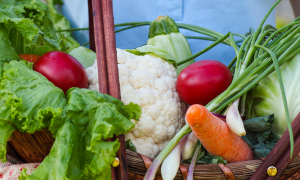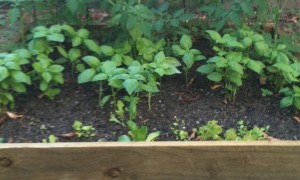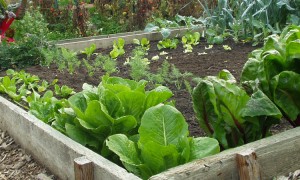By Fran J. Donegan
Growing vegetables in raised beds can produce a bountiful harvest in the fall. That may be reason enough to consider raised bed gardening, but there are plenty of others, as well.

Here are the five best advantages to planting your produce in a raised bed:
1. You can garden anywhere. A raised bed is a frame that contains soil. That means you can orient it to take full advantage of the sun and move it around the yard to find the best location. Pre-made beds come in a variety of sizes, which means you can place them close to the house for convenience. If you don’t have a lot of yard space, you can place your bed on your deck or patio—but if you do, be sure to build or buy a bed with a bottom and legs to keep it raised above the hard surface and allow for proper drainage.
2. You have complete control over the soil your vegetables grow in. Unlike a traditional garden where you start with the soil that is already there and work it to get it to an acceptable level, a raised bed lets you start with a blank slate. You determine the type of soil that is best. Basically, you want soil that contains a large amount of organic matter and drains well. The depth of the soil depends on the depth of the raised bed and the vegetables you will be growing, and whether the bed is open to the soil below. Just be sure to give the roots plenty of room.
When it is time to prepare the garden for winter, add a layer of compost to the soil. If you don’t have compost, use shredded leaves and grass clippings or rotted manure. Many gardeners add compost in the spring, which is fine, but adding it in the fall gives it more time to decompose in the soil. Simply till the organic matter into the soil with a garden fork.
Replenishing the soil is especially important for raised-bed gardens because they lose soil over time, and like any container, repeated plantings drains the soil of nutrients. Many people simply replace the soil in a raised bed and start over in the spring. That is not necessary. By adding organic matter, you will replenish the soil and keep the container full. Rotating the crops you plant also helps preserve the nutrients in the soil.
3. Raised beds produce higher yields than traditional gardening. Raised beds are not planted in the same manner as a traditional garden. Rather than planting a row of plants with a walkway separating the rows, the plants in a raised bed can be planted block style. In other words, plants are spaced an equal distance in all directions, creating a block of plants that are all spaced equidistance from one another. In a publication for the Colorado Master Gardeners program entitled “Block Style Layouts in Raised Vegetable Gardens,” the authors stated that this method of planting yields five times that of a traditional garden.
This approach is similar to the one found in the book All New Square Foot Gardening by Mel Bartholomew. Bartholomew starts with a square raised bed and then divides it into one-foot squares. Each square is planted with a different type plant. The number of plants in each square will depend on the size of the plant.
These methods result in larger harvests because more plants are put in the ground in a smaller space and the plants are spaced closer together than they would be in a traditional garden. Or, sow seeds by following the “thin to” spacing found on your seed packets. Because gardening conditions vary, experiment with different spacing. This is where a garden diary or log can help. Experience will help you determine the right plant spacing for your garden.
Because you don’t walk on a raised bed, there is no fear of compacting the soil, which can harm growing plants and reduce the overall yield.
4. Raised beds require less work than traditional gardens. Because plants are close together in a block layout, weed growth is discouraged, meaning you won’t need to weed often. And if the bed is deep enough and contains a ledge, you can sit and rest on the edge while weeding, trimming or watering. You also won’t need to bend down to reach your plants.
Watering a compact raised bed is easier than watering a large row garden. You can use a hose with a wand shower attachment, but soaker hoses or drip-irrigation systems are more efficient. Once they are set up, they deliver water directly to the base of the plant. Attaching a timer to the system is even more efficient.
Raised beds are easy to cover to provide protection from the sun or insects. They are also easy to fence in to keep out animals who may raid your garden.
5. Raised beds may be planted earlier than traditional gardens. The soil in a raised bed will warm up sooner than soil in the ground, so you may be able to get your veggies and flowers planted earlier in the growing season than you would with a traditional garden. The beds are also easy to cover if the forecast predicts a spring frost or heavier-than-usual rains.
Planting your garden in a raised bed will allow you more control and ease of use. They make it easy to get the garden you dream of with little work and a longer growing season.
Fran Donegan is a DIY home and garden writer who provides advice to homeowners for Home Depot. Fran’s tips on the advantages of raised garden beds are designed to help you obtain a bountiful harvest this growing season. To research a variety of raised garden bed materials, you can visit the Home Depot website here.






